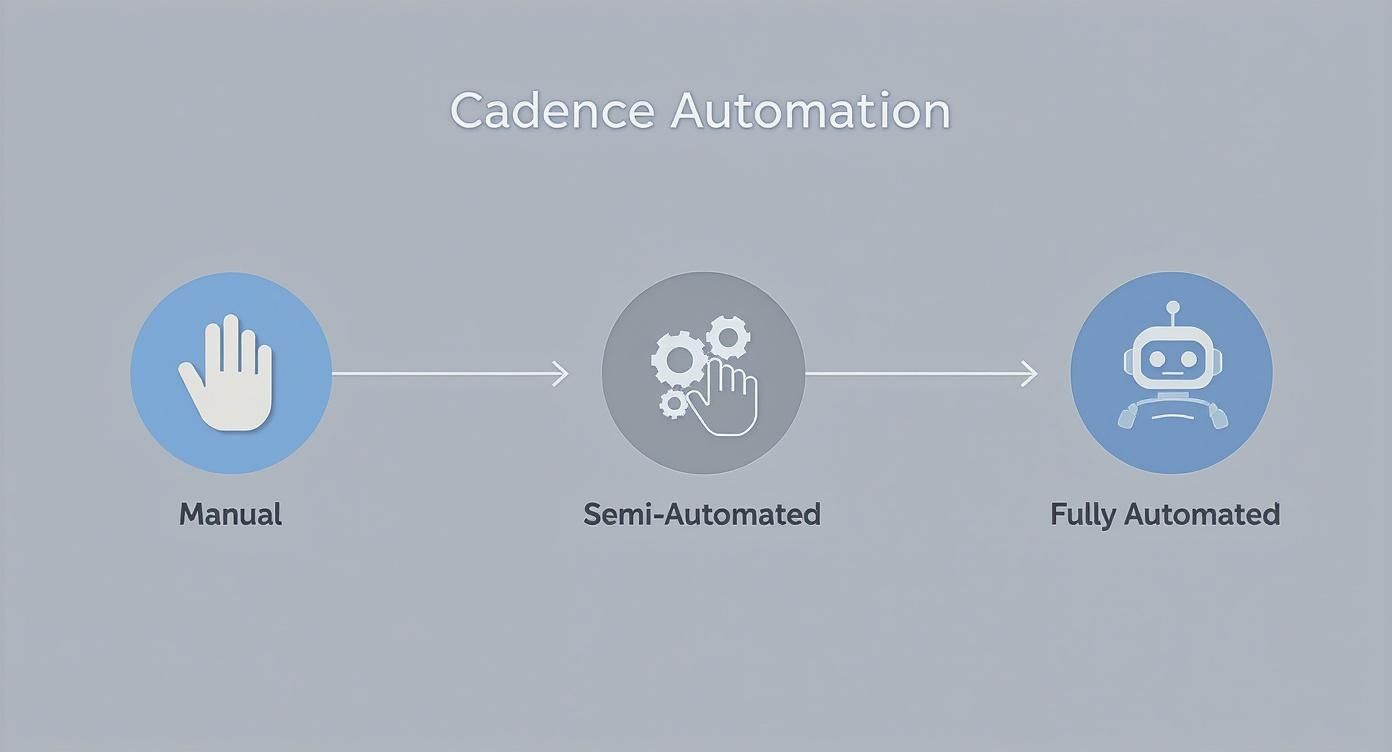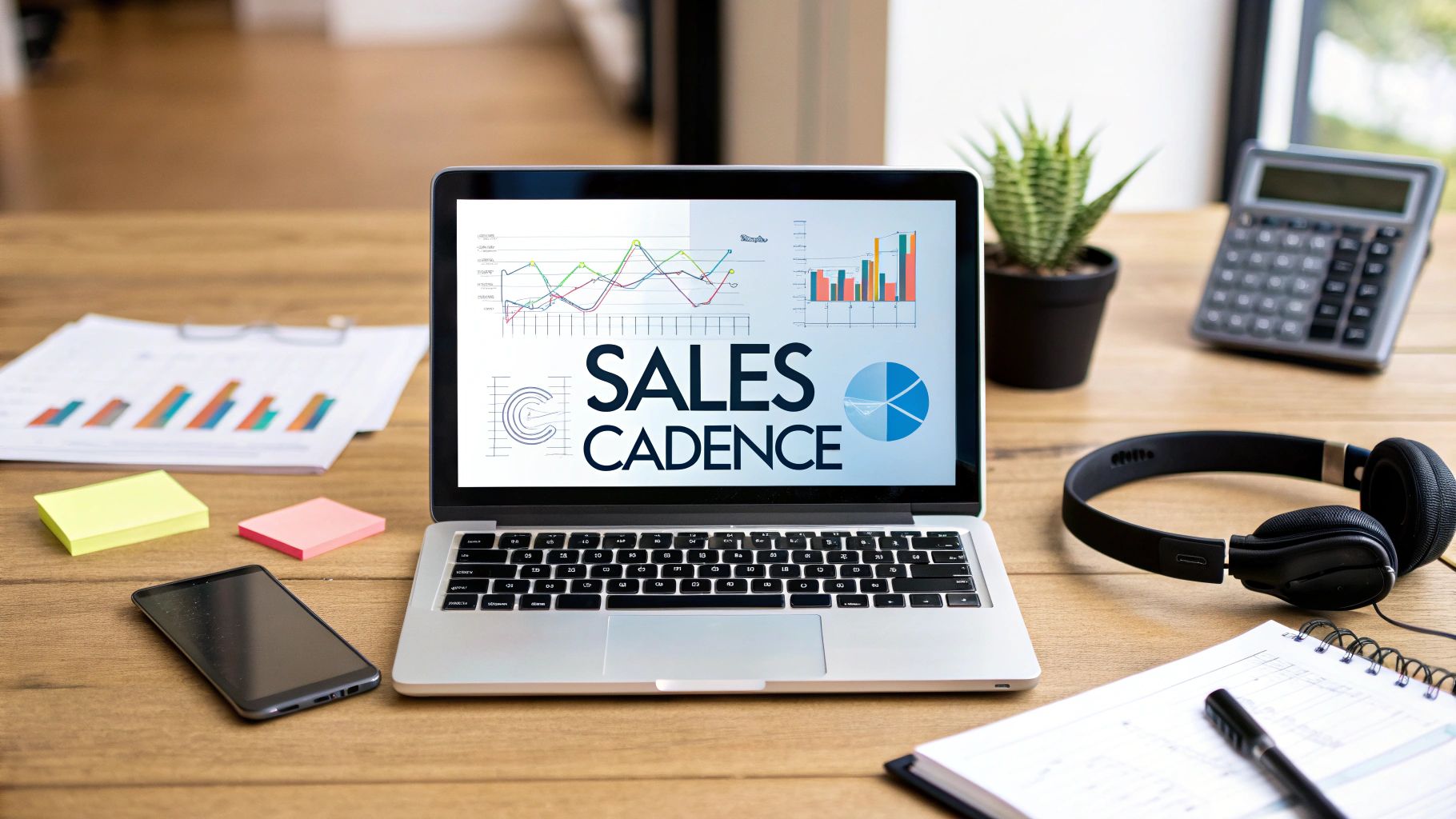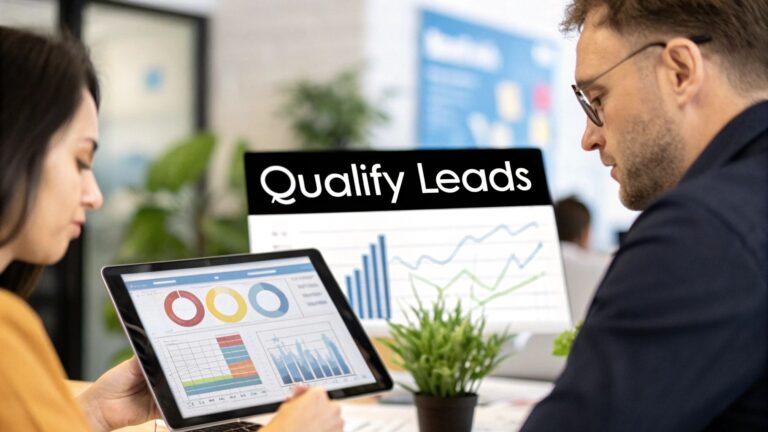Sales cadence best practices to boost B2B growth
The best sales cadences are a mix of art and science. They beautifully blend smart persistence, genuine personalization, and a multi-channel attack plan into a cohesive playbook for your sales team. This is about ditching the random "spray and pray" outreach and building a structured sequence of touchpoints that actually guides a prospect from being a name on a list to someone eager to talk.
What High-Performing Sales Cadences Actually Look Like
A truly effective sales cadence is so much more than a glorified to-do list for your reps; it’s a living, breathing asset that's absolutely critical for building a predictable pipeline. It takes the guesswork out of outreach and turns it into a methodical process designed to maximize every interaction.
Let’s be real, in the B2B world, decision-makers are drowning in messages. A thoughtfully designed cadence is what makes your outreach stand out from the rest of the noise flooding their inbox.
The whole point is to create a series of interactions that build on one another. Instead of a disconnected email one week and a random call the next, each touchpoint has a purpose and fits into a larger story you're telling. This kind of structured approach not only keeps your sales team consistent but also gives you a clear framework for measuring what’s working and what’s not.

Core Pillars of an Effective Sales Cadence
When you peel back the layers, every powerful sales cadence is built on a few fundamental pillars. Nailing these components is what allows you to build sequences that are both efficient for your team and genuinely compelling for your prospects. They are the strategic foundation for everything that follows.
This table breaks down the core components that form the backbone of any successful cadence.
| Pillar | Description | Key Objective |
|---|---|---|
| Strategic Touchpoints | The planned sequence of emails, calls, and social interactions, including their specific timing and frequency. | To maintain momentum and stay top-of-mind without ever overwhelming the prospect. |
| Multichannel Execution | Intentionally using a mix of communication channels—like email, phone, and LinkedIn—to connect with prospects where they are most active. | To dramatically increase visibility and boost your chances of getting a response. |
| Data-Driven Optimization | Constantly analyzing performance metrics (think open rates, replies, and meetings booked) to refine and improve the cadence. | To ensure your strategy evolves based on real-world feedback and gets better over time. |
By focusing on these three areas, you're not just sending messages; you're engineering a better sales conversation from the ground up.
Finding the Right Rhythm and Persistence
One of the first questions I always get is about the intensity of the outreach. How much is too much? Luckily, the data gives us a pretty clear answer: persistence pays off, big time.
Research consistently shows that a staggering 80% of sales require at least five follow-up calls after an initial meeting. It's not uncommon for reps to make eight attempts just to get a prospect on the phone in the first place. My experience backs this up—the sweet spot for an outbound cadence usually falls between 14 and 16 touches spread out over several weeks.
A great sales cadence isn't about being aggressive; it's about being professionally persistent. It shows you’ve done your homework, you believe in the value you're offering, and you respect the prospect's time enough to present that value in a thoughtful, structured way.
Ultimately, this disciplined follow-up is a crucial part of a much larger strategy. Getting these fundamentals right allows you to apply broader sales enablement best practices that empower your entire GTM team. Think of your cadence as the first, most important step in turning outreach from a game of chance into a science of conversion.
How to Architect Your Sales Cadence for Real Prospects

Let's be honest. Building a sales cadence that actually works isn't about blasting a generic sequence and hoping for the best. The most successful sales plays I've ever seen are built around one thing: the specific person you're trying to reach. A one-size-fits-all strategy is a surefire way to alienate most of your prospects.
The entire foundation of a great cadence comes from a deep, almost obsessive, understanding of your buyer personas. This goes way beyond a basic Ideal Customer Profile (ICP). You need to get into the heads of these people. What keeps them up at night? What are their real-world problems? How do they like to communicate?
For instance, you'd never approach a C-level executive the same way you’d talk to a department manager who’s in the trenches every day. The exec is thinking about high-level ROI and strategic wins, while the manager is sweating the details of team productivity and efficiency. Your cadence has to mirror their mindset.
Tailoring Cadences to Personas and Intent
Your very first move is to segment your audience. Stop thinking about building one "master" cadence. Instead, start with a few core templates designed for your key buyer personas and, just as importantly, their level of awareness.
A prospect who just downloaded a whitepaper is worlds away from a cold name on a list. Their intent is different, so your approach has to be, too.
Let's look at two common scenarios:
- Scenario A: The Warm Inbound Lead. This person just filled out your demo request form. They have sky-high intent and are actively looking for a fix. A shorter, more direct cadence is exactly what's needed here.
- Scenario B: The Cold Outbound Target. You've found a VP of Operations at a perfect-fit company, but they have no idea who you are. This calls for a much longer, value-first sequence designed to educate and build trust over time.
These two situations demand completely different game plans. Shoving a cold prospect into a fast, aggressive cadence is the quickest way to land in their spam folder.
Comparing Cadence Structures
So, what do these different approaches actually look like? The main things that change are the length of the cadence, the total number of touchpoints, and the channels you use to deliver them.
| Cadence Type | Ideal For | Duration | Touchpoints | Channel Mix |
|---|---|---|---|---|
| High-Intent Cadence | Warm Inbound Leads | 10-14 Days | 7-9 | Email-heavy, direct calls |
| Persistence Cadence | Cold Outbound Targets | 17-21 Days | 10-12+ | Balanced: LinkedIn, email, calls |
Getting this distinction right is everything. You're lining up your sales motion with where the prospect is in their buying journey. Before you even think about writing a single email, you need to know who you’re targeting. To get this segmentation right from the start, it's worth exploring different sales qualification frameworks that help you properly sort leads into the right cadence.
The Art of Multichannel Sequencing
Once you've defined who you're talking to and for how long, it’s time to pick your channels. One of the biggest mistakes I see teams make is leaning way too heavily on one channel—usually email. Real engagement comes from a smart mix of touchpoints across different platforms.
Think of each channel as a specialized tool in your outreach toolkit.
- LinkedIn: This is your go-to for low-friction initial contact and building social proof. A simple connection request on Day 1 can be far more effective than a long cold email.
- Email: The workhorse for delivering real value. Use it to share case studies, add context, and genuinely ask for their interest—not just their time.
- Phone Calls: This is your high-intent channel. Use calls to follow up on specific engagement (like when they open an email or click a link) or to simply cut through the digital noise with a human voice.
The goal of a multichannel cadence isn't to bombard the prospect from all sides. It's to create a cohesive conversation where each touchpoint builds on the last, making your outreach feel thoughtful and relevant.
A well-architected cadence might start with a LinkedIn connection, followed a day later by an email that references that connection, and then a call to follow up on a specific point you made. It creates a logical, natural flow that stands out from the flood of random, disconnected messages they get every day. This thoughtful planning is one of the most critical sales cadence best practices and it’s what separates the top-performing teams from everyone else.
Crafting Outreach That People Actually Respond To
A perfectly architected cadence is only half the battle. If the messages you send at each touchpoint are generic, irrelevant, or just plain self-serving, even the most thoughtfully planned sequence will fall flat.
The real magic happens in the words you choose. It's about crafting emails that get opened, voicemails that create curiosity, and social messages that feel like the start of a real conversation.
The core of this is a simple shift in mindset: you're not just executing tasks; you're weaving a cohesive story. Each message should build on the last, creating a sense of continuity and professional persistence. A call that references a specific point from a prior email feels thoughtful, not random. A LinkedIn message that reinforces your value proposition feels helpful, not spammy.

This interconnected approach is what makes your outreach feel like a genuine conversation unfolding over time, rather than a series of disconnected, automated blasts.
Beyond the [FirstName] Token
Let’s be honest: true personalization goes far beyond simply using a mail-merge tag for someone’s name. It's about demonstrating that you’ve actually done your homework and have some understanding of their world. This is how you earn the right to their attention.
Start by digging into your CRM and social platforms for real insights. Did they just get a promotion? Did their company publish a major case study or announce a new funding round? These are perfect, natural entry points for a message that proves you’re paying attention.
Here are a few ways to achieve this kind of personalization at scale:
- Trigger-Based Outreach: Reference a specific action they took, like downloading a guide or attending a webinar. Something like, "Saw you joined our webinar on AI operations—what was your biggest takeaway from the session?" works wonders.
- Role-Specific Pain Points: Address challenges that are unique to their job title. If you're talking to a VP of Sales, you might mention rep ramp time. For a CFO, the conversation might center on cost consolidation.
- Company News Hooks: Tie your message to a recent company announcement. For example: "Congrats on the Series B funding! As you scale your engineering team, managing cloud costs often becomes a key challenge…"
This level of detail immediately signals that your message isn't one of a thousand identical emails you blasted out that morning. It’s tailored, relevant, and immediately more valuable.
Core Messaging Templates for Critical Scenarios
While every message should feel personal, you don’t need to reinvent the wheel every single time. Having battle-tested templates for key stages of your cadence gives your reps a strong foundation they can quickly customize. When it comes to the email part of your cadence, incorporating proven email marketing best practices is non-negotiable for actually getting responses.
Here are the essential templates every team needs in their playbook:
- The Initial Cold Outreach Email: The goal here is simple: spark curiosity, not ask for a meeting. Keep it short (under 100 words), focus on a specific problem they likely face, and end with a soft call-to-action that asks for interest, not time.
- The Value-Add Follow-Up: This is not a "just checking in" message. Share something genuinely useful—a case study from their industry, a blog post that tackles their exact pain points, or a quick video tip.
- The "Break-Up" Email: After multiple attempts with no response, this is your last-ditch effort. A tactful message letting them know you're closing their file but remain a resource can sometimes, surprisingly, trigger a reply.
- The Social Selling Nudge: A LinkedIn message should be even more concise than an email. Reference a shared connection, a post they commented on, or a recent company update to make it feel organic.
The best messaging templates aren't rigid scripts but flexible frameworks. They provide the core structure and value proposition, leaving designated space for the sales rep to inject genuine, human personalization.
This strategy balances efficiency with the authenticity needed to cut through all the noise prospects face every day.
Weaving a Cohesive Narrative Across Channels
Your channels shouldn't operate in silos. The real power of a multichannel cadence comes from how the touchpoints interact with each other. We know from industry data that combining channels like email, phone, and social media dramatically boosts engagement. While email open rates often hover around 23% with a 1-3% response rate, a multi-pronged approach simply makes you more visible and increases your chances of connecting.
Here’s what that looks like in the real world:
- Day 1: Connect on LinkedIn (no message, just a connection request).
- Day 2: Send an email that references their recent post or some company news.
- Day 4: Call and leave a voicemail that directly mentions the email you sent. "Hi [Name], just following up on my email about [Topic]. Thought a quick chat might be easier."
This kind of cross-channel referencing makes each touchpoint feel more intentional and far less intrusive, creating a smooth and professional experience for the prospect.
Using Automation to Scale Without Sounding Like a Robot
Trying to run a high-touch, multichannel sales cadence for every single prospect by hand is a fast track to burnout. It's just not sustainable. This is where technology becomes your team's secret weapon, but the goal isn't to replace your reps—it's to free them up to do what they do best: build relationships and have actual conversations.
The most effective sales cadences I've seen strike a smart balance between automation and genuine personalization. When you get this right, automation handles all the monotonous, repetitive tasks. It makes sure no lead ever slips through the cracks and, most importantly, gives your reps back hours in their day.
It’s about working smarter, not just harder, letting you scale your outreach without sacrificing the quality of your interactions.
Finding Your Automation Sweet Spot
Not all automation is created equal, and there's no one-size-fits-all answer. The trick is to find the right balance for your team, your product, and the people you're selling to. For some teams, a fully automated sequence for lower-priority leads is a no-brainer. But for your high-value targets? Those demand a much more hands-on, personal approach.
Most modern sales engagement platforms, like Salesloft or HubSpot, make this pretty easy to set up. You can create rules that automatically enroll new webinar attendees into a specific follow-up sequence. Or you could trigger a manual call task for a rep the moment a prospect opens that key proposal email for the third time.
Here’s a quick look at how you might build and manage a cadence inside a platform like Salesforce.
This kind of visual builder lets managers map out every single step, blending automated emails with manual to-dos. It’s a great way to keep the whole team on the same page and working efficiently.
From my experience, the most powerful strategy is semi-automation. This is where reps work from pre-approved templates but are required to personalize key sections before anything goes out. It gives them guardrails to maintain quality but empowers them to add that crucial, human touch based on their own research. To make sure those messages hit the mark, it's worth checking out some practical tips for writing AI prompts that actually work.
Comparing Automation Levels
So, how much automation is too much? It really comes down to your sales motion and the lifetime value of your customers. A high-volume, transactional sales team will naturally lean more on full automation than a team selling complex, six-figure enterprise solutions. Understanding the tradeoffs of each approach is the first step.
To help you decide what fits your team, let’s compare the different levels of automation.
Automation Approaches for Sales Cadences
This table breaks down the three main strategies for managing cadences, from completely hands-off to fully manual.
| Approach | Best For | Pros | Cons |
|---|---|---|---|
| Fully Automated | Top-of-funnel lead nurturing, high-volume outreach, low-priority segments. | Maximum efficiency, scales infinitely, ensures consistent follow-up. | Can feel impersonal, risks sounding robotic, low personalization. |
| Semi-Automated | Core outbound prospecting for most target accounts and buyer personas. | Balances efficiency with personalization, reps can add timely insights. | Requires rep training and discipline, can be slower than full automation. |
| Manual | High-value strategic accounts, C-level executive outreach. | Highest level of personalization, builds stronger relationships. | Not scalable, time-intensive, high risk of human error or inconsistency. |
Ultimately, picking the right level is about finding the blend that supports your team instead of getting in their way.
The ultimate goal of automation isn't to remove the salesperson from the process. It's to remove the tedious, administrative work so they can spend more time researching, personalizing, and actually selling.
When you strategically automate the right parts of your sequence, you create a system that runs smoothly in the background. This frees up your reps to focus their energy on the high-impact activities that actually close deals. For teams just getting started, it helps to understand the fundamentals of what sales automation is and how it applies beyond just email. That foundation will help you build a process that truly empowers your reps.
Measuring Your Cadence Performance to Drive Improvement
A powerful sales cadence isn't a "set it and forget it" tool. Think of it more like a living playbook that has to evolve. I’ve seen firsthand that the single biggest habit of high-performing sales teams is building a data-driven feedback loop. This is what moves you away from guesswork and into a repeatable process of continuous improvement, turning good cadences into great ones.
Your goal is to understand the story your metrics are telling. Each number is a clue that points to a specific strength or weakness in your outreach. Just tracking the data isn't enough; you have to know how to interpret it and, more importantly, how to act on what you learn.
Identifying Your Core Cadence KPIs
To get started, you need to focus on a handful of essential key performance indicators (KPIs). Drowning in data is just as bad as having none. From my experience, these four metrics will give you a clear, immediate picture of your cadence's health and where it needs attention.
- Email Open Rates: This is your first hurdle. It’s a direct measure of how effective your subject lines and preview text are. If you’re seeing low open rates, that’s a dead giveaway that your initial hook isn't compelling enough to cut through a noisy inbox.
- Reply Rates: This tells you if your message is actually resonating. Once they've opened the email, are you giving them a solid reason to engage? A low reply rate almost always points to a weak value proposition or a call-to-action that isn't clear or relevant enough.
- Call Connection Rates: How often are your reps actually speaking to a human? This KPI helps you figure out the quality of your contact data and whether you're calling at the right times.
- Meeting Booked Rate: This is the ultimate bottom-line metric for any cadence. It measures the percentage of prospects who enter your sequence and end up scheduling a discovery call or demo. It’s the truest indicator of your cadence’s overall success.
Monitoring these numbers gives you a roadmap for optimization. Low open rates mean you test subject lines. Low reply rates mean you refine your messaging. Every piece of data is an opportunity to get better.
As you get better at this, your process will naturally mature. Most teams progress from manual outreach to more sophisticated, automated systems as they scale.

This is a pretty typical journey as teams get more sophisticated with their cadence automation.
From Insights to Actionable Improvements
Knowing your numbers is one thing; using them to drive change is another entirely. You need a simple, repeatable framework for testing and iteration. A/B testing is your best friend here, as it lets you scientifically test one variable at a time to see what truly moves the needle.
For instance, if your call-to-connect rate is lagging, you could test:
- Call Timing: Have Group A make calls between 9-11 AM, and Group B make calls between 4-5 PM.
- Voicemail Script: Give each group a different voicemail script—one focused on value, the other on sparking curiosity.
By isolating a single variable, you can confidently attribute any change in performance to the element you tested. This systematic approach is how you build a playbook that's backed by your own data, not just industry assumptions.
A great sales cadence isn't born from a perfect template. It's forged through constant experimentation, measurement, and the courage to change what isn't working based on real-world feedback from your prospects.
This iterative process ensures your outreach strategy never gets stale. The data backs this up, too. Most research suggests cadences should include 8-12 touchpoints over two to four weeks. Tracking metrics like email replies and call connections is crucial, with a solid goal being a connect-to-booking rate of 10% or higher. The best way to hit these benchmarks is by consistently A/B testing to see what clicks with your specific audience. You can discover more insights about these essential templates and the data behind them.
Ultimately, measuring performance is about creating a culture of optimization. When your team sees data not as a judgment but as a tool for improvement, you unlock a powerful engine for predictable growth.
Answering the Tough Questions About Sales Cadences
Even the best-laid plans run into hiccups. When you're in the trenches building and running sales cadences, practical questions always pop up. Getting straight answers to these common challenges is what separates a sequence that fizzles out from one that crushes its goals.
Let's dive into the "what ifs" and "how-tos" that sales teams grapple with every day, based on what actually works.
What’s the Ideal Length for a Sales Cadence?
There's no single magic number, but there's definitely a sweet spot. Most of the data, and my own experience, points to a cadence that runs between 17 and 21 days.
Why that window? It strikes a critical balance. You have enough time to build a little familiarity and show your value without completely overwhelming your prospect. Anything shorter feels rushed and pushy, while a cadence that drags on for a month or more just gives the lead too much time to go cold. The aim is professional persistence, and this timeframe is just about right.
How Many Touchpoints Should I Include?
Again, it’s all about quality over quantity, but you need a baseline. A high-performing cadence will almost always have somewhere between 8 and 12 touchpoints.
If you have fewer than eight touches, you’re probably not going to cut through the noise. Simple as that. But push it past twelve, and you start running a serious risk of annoying your prospect and burning the lead for good. The trick is to spread these touches across different channels—think phone, email, and social—so you're visible without being a pest on any single platform.
The most effective approach is to never over-index on one type of outreach. Give people the space to receive your message and respond on their own terms. This value-led strategy is far more likely to earn a reply.
Do I Need Different Cadences for Different Regions?
One hundred percent, yes. Taking a one-size-fits-all approach to global outreach is a surefire way to get ignored. What works in one country can fall completely flat—or even be seen as rude—in another. Your cadences must account for these cultural nuances.
For instance, here are a few things sales teams learn quickly:
- Cold calling is a much more accepted practice in the US market than it is in many parts of Europe.
- You can often get a response with fewer total touchpoints in the APAC and EMEA regions.
- That aggressive "triple touch" (call, email, and LinkedIn message all on day one) can come across as way too intrusive in places like the DACH region (Germany, Austria, Switzerland).
How Many Cadences Do We Really Need?
It’s easy to fall into the trap of creating a unique cadence for every little scenario, but that gets out of hand fast. Simplicity is your best friend here. For most teams, a handful of core templates is all you need to be effective.
A great place to start is with three primary types:
- A highly personalized cadence: Reserved for your top-tier, must-win accounts.
- A persona-based cadence: Built around the specific pain points of a key job title you're targeting.
- A standard, broader cadence: Used to test the waters with new or lower-priority accounts.
This simple structure gives you the flexibility to stay relevant without drowning your sales team in complexity.
At MakeAutomation, we specialize in designing and implementing the precise AI and automation frameworks that turn these best practices into reality. We help B2B and SaaS teams build scalable outreach systems that save time and drive predictable growth. Learn how we can optimize your sales engine.







